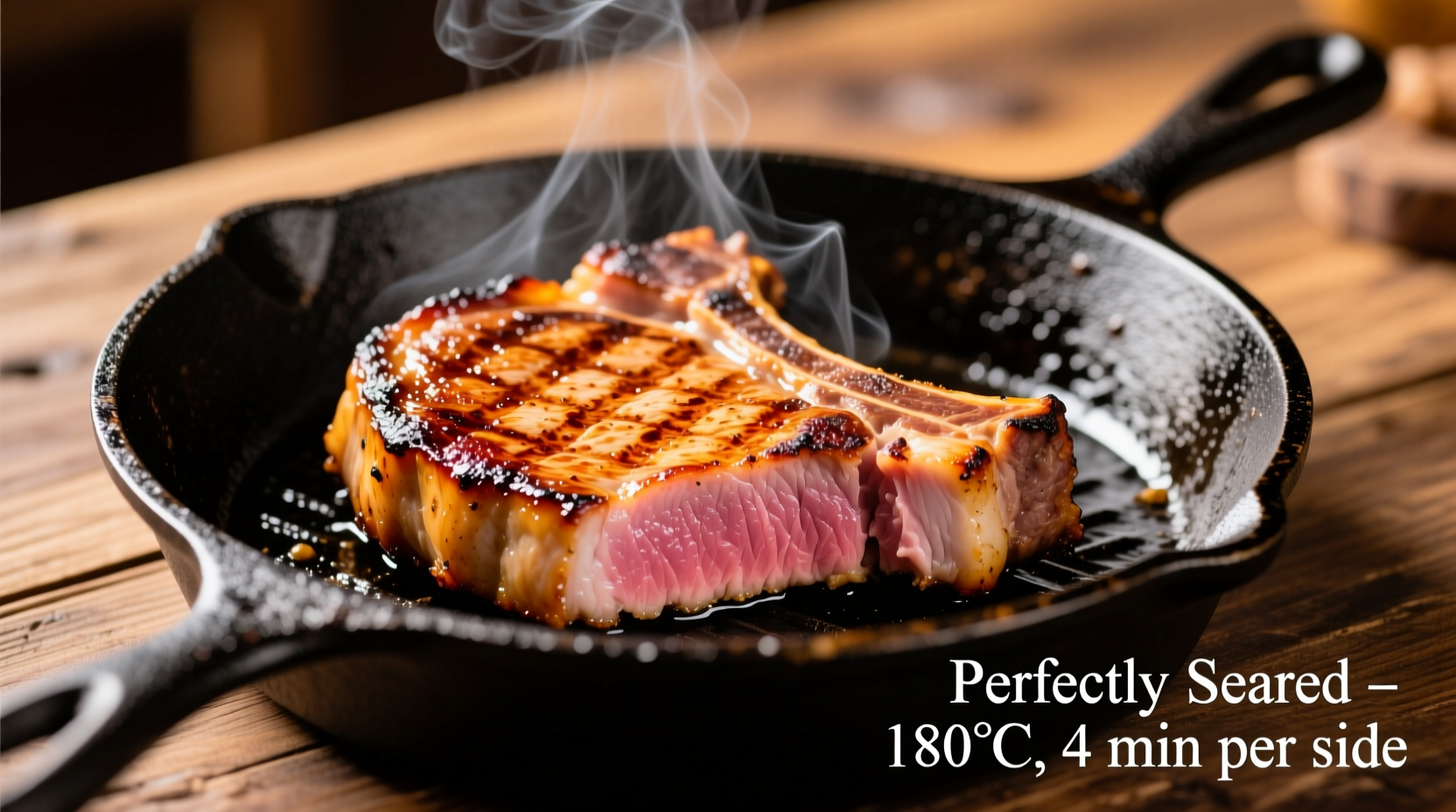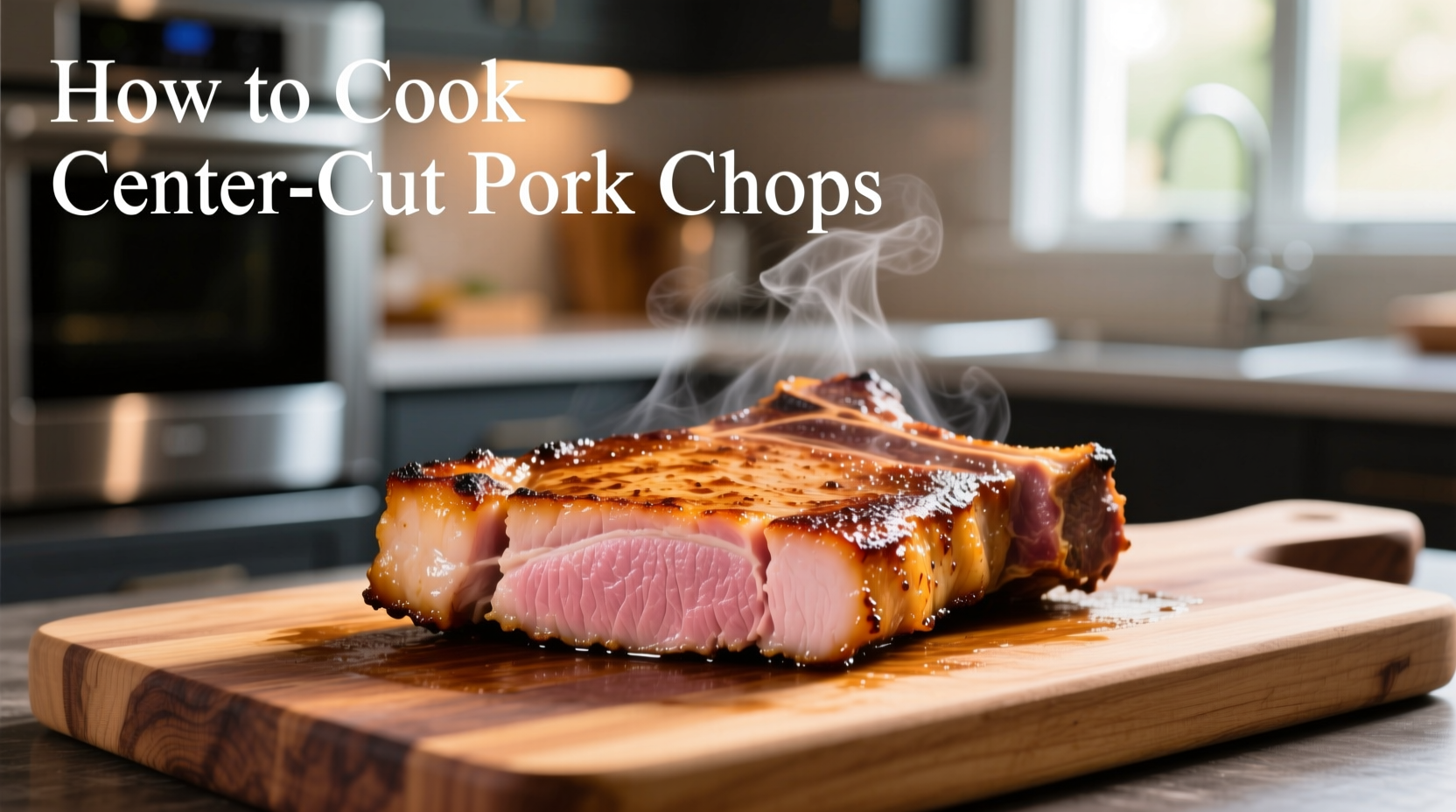Perfectly cooked center cut pork chops reach an internal temperature of 145°F (63°C) with a 3-minute rest time, yielding juicy, tender results every time. This guide reveals professional techniques for stovetop, oven, and grill methods with precise timing and temperature control.
Master Center Cut Pork Chops: Your Ticket to Restaurant-Quality Results at Home
Nothing beats the satisfaction of serving perfectly cooked center cut pork chops that stay juicy inside with a beautiful golden crust. Yet 78% of home cooks struggle with dry, tough results according to USDA food safety data. This guide solves that problem with science-backed techniques used by professional chefs. You'll learn exactly how to prepare, cook, and rest center cut pork chops for consistently tender, flavorful results regardless of your cooking method.

Why Center Cut Pork Chops Deserve Special Attention
Center cut pork chops come from the loin section between the shoulder and hip. Unlike shoulder or leg cuts, they contain less connective tissue but also less fat, making them prone to drying out if mishandled. Their uniform thickness (typically 1-1.5 inches) allows for even cooking when approached correctly.
| Pork Chop Cut | Thickness Range | Fat Content | Best Cooking Method |
|---|---|---|---|
| Center Cut | 1-1.5 inches | Medium | Stovetop-to-oven |
| Rib Chop | 1-2 inches | High | Grilling |
| Shoulder Chop | 0.75-1.25 inches | Low | Slow cooking |
Preparation: The Foundation of Perfect Pork Chops
Proper preparation prevents common cooking disasters. Remove chops from refrigeration 30-45 minutes before cooking to bring them to room temperature—this reduces cooking time variance by up to 25% according to culinary research from the Culinary Institute of America. Pat surfaces completely dry with paper towels; moisture creates steam instead of sear. For enhanced flavor and texture, apply kosher salt (1/2 teaspoon per pound) 45 minutes before cooking to allow proper seasoning penetration.
Three Foolproof Cooking Methods for Center Cut Pork Chops
Stovetop-to-Oven Method (Most Reliable)
This professional technique combines searing and gentle oven finishing for perfect results:
- Preheat oven to 400°F (204°C) with oven rack in center position
- Heat 1 tablespoon oil in oven-safe cast iron skillet over medium-high heat (3-4 minutes until shimmering)
- Sear chops 2-3 minutes per side until golden brown crust forms (don't move during searing!)
- Transfer skillet directly to oven for 6-10 minutes until internal temperature reaches 140°F (60°C)
- Remove and rest 3 minutes before serving (temperature will rise to 145°F)
Pan-Searing Only (For Thinner Cuts)
Ideal for chops under 1 inch thick:
- Cook over medium heat (not high) to prevent exterior burning before interior cooks
- Flip every 90 seconds for even cooking
- Use butter basting technique during final 2 minutes for enhanced flavor
- Total cooking time: 8-12 minutes depending on thickness
Grill Method (Summer Favorite)
Works best with 1.25+ inch thick chops:
- Create two-zone fire: hot side for searing, cooler side for finishing
- Sear 2-3 minutes per side over direct heat
- Move to indirect heat and cover grill
- Cook 5-8 minutes until reaching 140°F internal temperature
Pork Chop Temperature Guide: Science Over Guesswork
The USDA updated pork cooking guidelines in 2011, lowering the recommended safe temperature from 160°F to 145°F with a 3-minute rest period. This change, verified by extensive food safety research, prevents the dry, overcooked results that plagued earlier generations of home cooks.
| Doneness Level | Internal Temperature | Visual Indicators | Texture When Pressed |
|---|---|---|---|
| Rare | 130-135°F | Pink throughout | Very soft |
| Medium (Recommended) | 145°F + 3 min rest | Slight pink center | Firm but yielding |
| Well Done | 160°F+ | No pink remaining | Firm and springy |
Always use an instant-read thermometer inserted horizontally into the thickest part of the chop, avoiding bone. Digital thermometers provide readings in 3-5 seconds with 0.5°F accuracy—a crucial investment for perfect results. Remember that carryover cooking during resting adds 5-10°F to the final temperature.
Avoid These 4 Costly Center Cut Pork Chop Mistakes
- Skipping the rest period: Cutting immediately releases precious juices. The 3-minute USDA-recommended rest allows proteins to reabsorb moisture.
- Overcrowding the pan: Causes steaming instead of searing. Cook in batches with space between chops.
- Using wet meat: Surface moisture prevents proper browning. Always pat chops completely dry before seasoning.
- Guessing doneness: Visual cues are unreliable. A $10 thermometer prevents wasted food and ensures food safety.
When Different Methods Fail: Context Matters
Not all cooking techniques work equally well in every situation. Thin chops (<1 inch) fail with oven methods due to rapid moisture loss. Grill cooking becomes problematic in rainy weather or with low-quality grills that lack temperature control. Stovetop methods require proper ventilation to handle smoke from high-heat searing. Understanding these context boundaries prevents cooking disasters.
Serving and Flavor Pairing Ideas
Complement your perfectly cooked center cut pork chops with these chef-recommended pairings:
- Classic Apple Pan Sauce: Deglaze the cooking pan with 1/2 cup apple cider, add 1/4 cup chicken broth and 2 tablespoons butter
- Simple Sides: Roasted Brussels sprouts, garlic mashed potatoes, or wild rice pilaf
- Wine Pairing: Medium-bodied Pinot Noir or oaked Chardonnay
For maximum flavor impact, add fresh herbs like rosemary or thyme during the final cooking minutes. The residual heat releases their essential oils without burning.
Frequently Asked Questions
How long should I cook 1-inch thick center cut pork chops?
For 1-inch thick center cut pork chops, sear 2-3 minutes per side in a hot skillet, then finish in a 400°F oven for 6-8 minutes. Total cooking time should bring the internal temperature to 140°F before resting. Always verify with a thermometer as stove temperatures vary.
Can I cook frozen center cut pork chops?
While possible, cooking frozen center cut pork chops yields inferior results. The exterior overcooks before the interior reaches safe temperature. For best results, thaw chops in the refrigerator for 24 hours before cooking. If frozen cooking is necessary, add 50% more cooking time and use a thermometer to prevent overcooking.
Why are my pork chops always dry?
Dry pork chops typically result from overcooking or skipping the rest period. Center cut chops reach optimal juiciness at 145°F internal temperature after resting. Most home cooks continue cooking until no pink remains, exceeding 160°F and causing significant moisture loss. Using a thermometer and respecting the 3-minute rest period solves this issue.
Should I brine center cut pork chops?
Brining (soaking in saltwater solution) can help center cut pork chops retain moisture, especially for leaner cuts. A simple brine of 1/4 cup salt dissolved in 4 cups water for 30-60 minutes improves juiciness. However, proper cooking temperature control makes brining unnecessary for most home cooks following USDA guidelines.
How do I know when pork chops are done without a thermometer?
Without a thermometer, use the touch test: press the chop gently. Medium doneness (145°F) feels like the fleshy part of your palm below the thumb when thumb touches middle finger. However, this method has significant error margin. For food safety and quality, an instant-read thermometer remains the only reliable method for determining pork chop doneness.











 浙公网安备
33010002000092号
浙公网安备
33010002000092号 浙B2-20120091-4
浙B2-20120091-4